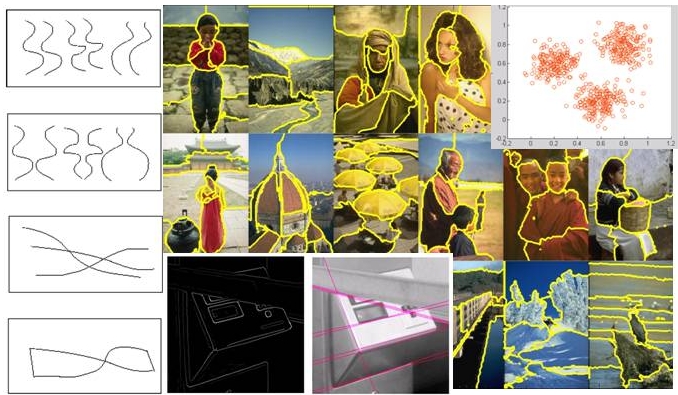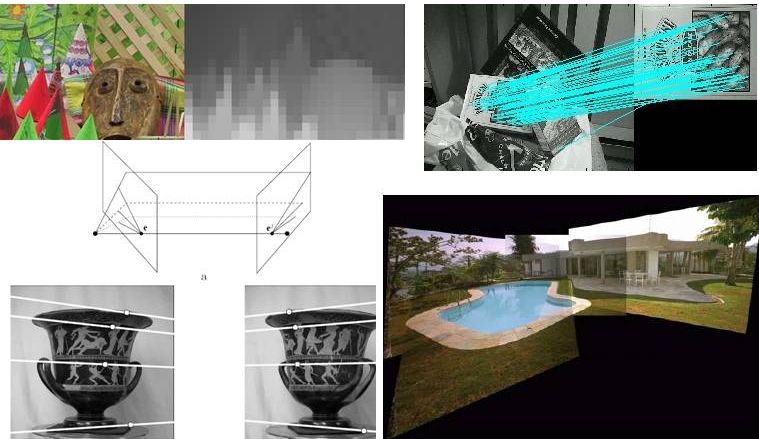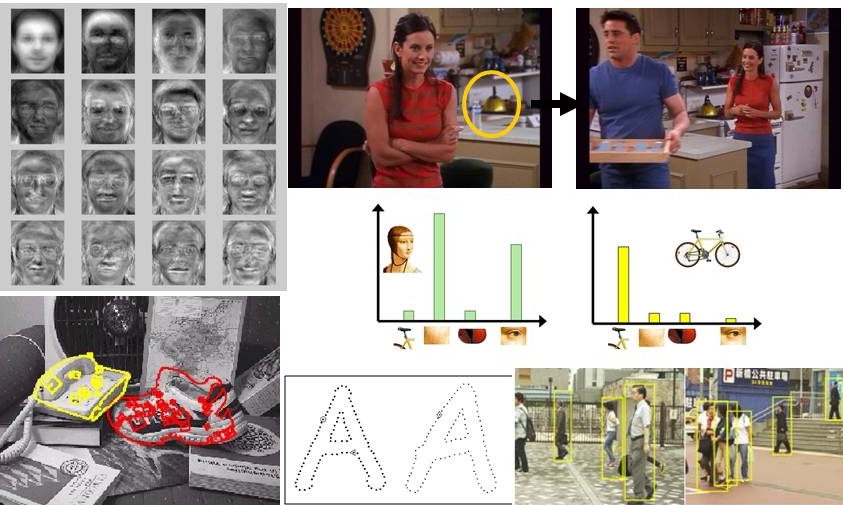http://www.cs.utexas.edu/~grauman/courses/spring2011/index.htmlCS 376: Computer Vision
Spring 2011
Mon/Wed 11:00 am - 12:15 pm
UTC 3.124
Please come to any of our office hours for questions about assignments or lectures.
Questions via email about an assignment should be sent to:
cv-spring2011@cs.utexas.edu, with "CS376" in the beginning of the subject line.
This will ensure the most timely response from the instructor or TA.
Announcements
The final exam slot has been confirmed by the registrar: Monday May 16, 2-5 pm, in JGB 2.102. You may bring two sheets of notes on 8.5 x 11" paper. The exam is comprehensive.
Overview
Schedule
Links
Spring 2011
Mon/Wed 11:00 am - 12:15 pm
UTC 3.124
| Instructor: Kristen Grauman Office location: ACE 3.446 Office hours: Wed 5-6 pm, and by appointment. |
| TA: Shalini Sahoo shalini@cs.utexas.edu Office location: PAI 5.33 TA station, desk 3 Office hours: Tues/Thurs 5-6 pm |
| TA (office hours only): Yong Jae Lee Office location: PAI 5.33 TA station, desk 3 Office hours: Mon 5-6 pm |
Questions via email about an assignment should be sent to:
cv-spring2011@cs.utexas.edu, with "CS376" in the beginning of the subject line.
This will ensure the most timely response from the instructor or TA.
Announcements
The final exam slot has been confirmed by the registrar: Monday May 16, 2-5 pm, in JGB 2.102. You may bring two sheets of notes on 8.5 x 11" paper. The exam is comprehensive.
View all current grades and late days used on Blackboard.
Overview
Course description: Billions of images are hosted publicly on the web---how can you find one that “looks like” some image you are interested in? Could we interact with a computer in richer ways than a keyboard and mouse, perhaps with natural gestures or simply facial expressions? How can a robot identify objects in complex environments, or navigate uncharted territory? How can a video camera in the operating room help a surgeon plan a procedure more safely, or assist a radiologist in more efficiently detecting a tumor? Given some video sequence of a scene, can we synthesize new virtual views from arbitrary viewpoints that make a viewer feel as if they are in the movie?
In computer vision, the goal is to develop methods that enable a machine to “understand” or analyze images and videos. In this introductory computer vision course, we will explore various fundamental topics in the area, including image formation, feature detection, segmentation, multiple view geometry, recognition and learning, and video processing. This course is intended for upper-level undergraduate students.
Textbook: The textbook is Computer Vision: Algorithms and Applications, by Rick Szeliski. It is currently available for purchase e.g. at Amazon for ~$65. An electronic copy is also available free online here. I will also select some background reading on object recognition from this short book on Visual Object Recognition that I prepared together with Bastian Leibe.
Syllabus: Details on prerequisites, course requirements, textbooks, and grading policy are posted here. A high-level summary of the syllabus is here.
Problem set deadlines: Assignments are due about every two weeks. The dates below are tentative and are provided to help your planning. They are subject to minor shifts if the lecture plan needs to be adjusted slightly according to our pace in class.
In computer vision, the goal is to develop methods that enable a machine to “understand” or analyze images and videos. In this introductory computer vision course, we will explore various fundamental topics in the area, including image formation, feature detection, segmentation, multiple view geometry, recognition and learning, and video processing. This course is intended for upper-level undergraduate students.
Textbook: The textbook is Computer Vision: Algorithms and Applications, by Rick Szeliski. It is currently available for purchase e.g. at Amazon for ~$65. An electronic copy is also available free online here. I will also select some background reading on object recognition from this short book on Visual Object Recognition that I prepared together with Bastian Leibe.
Syllabus: Details on prerequisites, course requirements, textbooks, and grading policy are posted here. A high-level summary of the syllabus is here.
Problem set deadlines: Assignments are due about every two weeks. The dates below are tentative and are provided to help your planning. They are subject to minor shifts if the lecture plan needs to be adjusted slightly according to our pace in class.
- Pset 0 due Jan 28
- Pset 1 due Feb 14 (tentative)
- Pset 2 due Mar 2 (tentative)
- Pset 3 due Mar 28 (tentative)
- Pset 4 due April 18 (tentative)
- Pset 5 due May 4 (tentative)
Schedule
| Dates |
Topic |
Readings and links |
Lectures |
Assignments, exams | |
| Wed Jan 19 |
Course intro |
Sec 1.1-1.3 |
Intro [pdf] |
Pset 0 out Friday Jan 21 | |
 |
Mon Jan 24 |
Features and filters |
Sec 3.1.1-2, 3.2 |
Linear filters [ppt] [pdf] [outline] |
|
| Wed Jan 26 |
Sec 3.2.3, 4.2 Seam carving paper Seam carving video |
Gradients and edges [ppt] [pdf] [outline] |
Pset 0 due Friday Jan 28 | ||
| Mon Jan 31 |
Sec 3.3.2-4 |
Binary image analysis [ppt] [pdf] [outline] |
Pset 1 out [class results] | ||
| Wed Feb 2 |
Sec 10.5 Texture Synthesis |
Texture [ppt] [pdf] [outline] |
|||
| Mon Feb 7 | Sec 2.3.2 Foundations of Color, B. Wandell Lotto Lab illusions |
Color [ppt] [pdf] [outline] |
Pset 0 grades and solutions returned in class | ||
 |
Wed Feb 9 |
Grouping and fitting | Sec 5.2-5.4 |
Segmentation and clustering [ppt] [pdf] [outline] |
|
| Mon Feb 14 |
Sec 4.3.2 |
Hough transform [ppt] [pdf] [outline] |
Pset 1 due Monday Feb 14 Pset 2 out | ||
| Wed Feb 16 | |||||
| Mon Feb 21 |
Sec 5.1.1 |
Deformable contours [ppt] [pdf] [outline] |
|||
| Wed Feb 23 |
Sec 2.1.1, 2.1.2, 6.1.1 |
Alignment and 2d image transformations [ppt] [pdf] [outline] |
Pset 1 grades and solutions returned in class | ||
 |
Mon Feb 28 |
Multiple views and motion |
Sec 3.6.1, 6.1.4 |
Homography and image warping [ppt] [pdf] [outline] |
|
| Wed Mar 2 |
Sec 4.1 |
Local invariant features 1 [ppt] [pdf] [outline] |
Pset 2 due Wednesday Mar 2 | ||
| Mon Mar 7 |
(Sec 4.1) | Local invariant features 2 [ppt] [pdf] [outline] |
|||
| Wed Mar 9 |
Midterm exam Pset 2 grades and solutions returned in class | ||||
| Spring break |
Pset 3 out [class results] | ||||
| Mon Mar 21 |
Sec 11.1.1, 11.2-11.5 |
Image formation (and local feature matching wrap-up) [ppt] [pdf] [outline] |
|||
| Wed Mar 23 |
Sec 11.1.1, 11.2-11.5 Epipolar geometry demo Audio camera, O'Donovan et al. |
Stereo 1: Epipolar geometry [ppt] [pdf] [outline] |
|||
| Mon Mar 28 | Virtual viewpoint video, Zitnick et al. |
Stereo 2: Correspondence and calibration [ppt] [pdf] [outline] |
|||
 | |||||
| Wed Mar 30 |
Recognition | Grauman & Leibe Ch 1-4 (3 is review) |
Indexing local features [ppt] [pdf] [outline] |
Pset 3 due Wed March 30 | |
| Mon April 4 |
Grauman & Leibe Ch 5, 6 Szeliski 14.3 Video Google demo by Sivic et al., paper |
Instance recognition [ppt] [pdf] [outline] |
|||
| Wed April 6 |
Grauman & Leibe Ch 7, 8.1, 9.1, 11.1 Szeliski 14.1 |
Intro to category recognition [ppt] [pdf] [outline] |
Pset 3 grades and solutions returned in class Pset 4 out | ||
| Mon April 11 |
Grauman & Leibe Ch 7, 8.1, 9.1, 11.1 Szeliski 14.1 Viola-Jones face detection paper (for additional reference) |
Face detection [ppt] [pdf] [outline] |
|||
| Wed April 13 |
Grauman & Leibe 11.3, 11.4 Szeliski 14.4 |
Discriminative classifiers for image recognition [ppt] [pdf] [outline] |
|||
| Mon April 18 |
Grauman & Leibe 11.3, 11.4 Szeliski 14.4 |
Part-based models [ppt] [pdf] [outline] |
|||
 |
Wed April 20 |
Video processing |
8.4, 12.6.4 |
Motion [ppt] [pdf] [outline] |
Pset 4 due Wed April 20 |
| Mon April 25 |
8.4, 12.6.4 Davis & Bobick paper: The Representation and Recognition of Action Using Temporal Templates Stauffer & Grimson paper: Adaptive Background Mixture Models for Real-Time Tracking. |
Background subtraction, Action recognition [ppt] [pdf] [outline] |
Pset 5 out | ||
| Wed April 27 |
5.1.2, 4.1.4 |
Tracking [ppt] [pdf] |
Pset 4 grades and solutions returned | ||
| Mon May 2 |
Course wrap-up and review |
||||
| Wed May 4 |
|||||
| Pset 5 due Sun May 8 | |||||
| Mon May 16 2-5 pm |
Final exam in JGB 2.102 | ||||
Links
- Accessing Matlab at UT
If you're using gnome on the new package machines and are trying to use Matlab you'll notice that you get a blank Matlab window. To fix the problem click on System Menu - Preferences - Appearance, then pick 'Visual Effects' tabs. Set the effect to None and close the window. Matlab will start up normally after that. - Having Matlab license issues? See tips here (thanks Yong Jae)
- Getting started with Matlab: basic tutorial
- Blackboard
- UTCS Computing / Facilities web page
- CV Online
- OpenCV (open source computer vision library)
- Weka (Java data mining software)
- Compiled list of image datasets
- Netlab (matlab toolbox for data analysis techniques, written by Ian Nabney and Christopher Bishop)
- Computer vision conferences
- Annotated computer vision bibliography
- Face recognition homepage
- Computer vision research groups
- Vision related links on AAAI.org page
- Grauman & Leibe - Visual Object Recognition - short book in Synthesis lecture series
- Also see above in our syllabus for links relevant per lecture.
'Computer Vision' 카테고리의 다른 글
| Logistic Regression에 대한 간단한 설명 (0) | 2013.06.26 |
|---|---|
| Kristen Grauman - Visual Object Recognition and Image Search (0) | 2013.06.12 |
| Kristen Grauman - Special Topics in Computer Vision, Spring 2010 (1) | 2013.06.05 |
| Kristen Grauman - Visual Recognition, Fall 2011 (0) | 2013.06.05 |
| Kristen Grauman - Visual Recognition, Fall 2012 (0) | 2013.06.05 |



